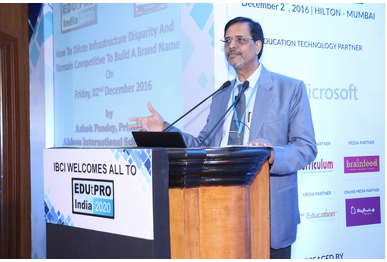Does Infrastructure Correlate with Learning Outcomes?
- Ashok K Pandey
- Dec 15, 2016
- 3 min read

The issue of infrastructural inputs in the functioning of schools is intensely debated in the educational circuits. India with its vast diversity is a host to over 1.5 million schools across the country. The infrastructure varies from one classroom, one teacher, many students to some of the finest facility schools. They are comparable with the best in the world, with handsome teacher taught ratio.
It is unfortunate but true that even after 70 years of independence most of the schools lack even the hygiene level infrastructure. When we talk of good infrastructure, the connotation invariably is that of a glossy building, posh corridors, ostentatious facilities, outsourced canteens and five-star gymnasium. However, seen in the contextual reality of India, ensuring a necessary support system comprising well-lit classrooms, library, laboratories, provision for co-curricular activities and sports, clean drinking water, toilets for boys and girls is mandatory. Any addition to this is a plus but not a guarantee for better learning outcomes.
In a conference organised by EDUtPRO INDIA 2020 in Mumbai recently, I was invited to speak on the subject of infrastructural disparity and building a brand institution. I have rested my case on infrastructure in the preceding paragraphs. I have argued for a very long time that schools are built with the help of many other important capitals. I list them as intellectual capital based on the competency and scholarship of teachers, moral and ethical capital determined by the culture and value system of the organisation. Another essential ingredient of a great institution is the leadership capital, defined by vision, mission, core values and accountability quotient.

We all agree that holistic education encompasses imparting knowledge, teaching the art of living, imbuing exploration and creativity and above all offering a fulfilling experience to the students. These aspects of holistic education give further insight if we look at what the young learners aspire to do beyond school. We have to prepare them for college and life. They have to fit culturally in the organization, exhibit poise, and respect and add value to the organisational endeavours.
We, therefore, need to revitalise our institutions by demonstrating commitment, focusing on the right means for good outcomes and developing a trust mark rather than a trademark. We can reach the hearts and minds of the students and parents only by creating a space where the services that we provide match the expectations that they have. Differentiation is the key in our classrooms, and therefore schools must respond to address the individual needs and aspirations. Parents are the key stakeholders and schools must develop a mechanism for obtaining feedback from them. The leadership of the great institutions does not shy away from asking some tough questions to themselves. Some of these issues are:
What are our function and purpose?
How are we unique?
What is our larger vision?
Are we preparing our students for life?
Are we offering more value for the investment made?
The answer to these questions lay the ground for us to operate, design our curriculum, adapt new pedagogy and win the trust of the learners. Only then we can have the edge over the others and be innovative. Branding, in my opinion, is not about catchy phrases, glossy photographs, beautiful website and logos; it goes deeper than that. And that means there should be no mismatch between the promises we make and the services we deliver.

Commenti